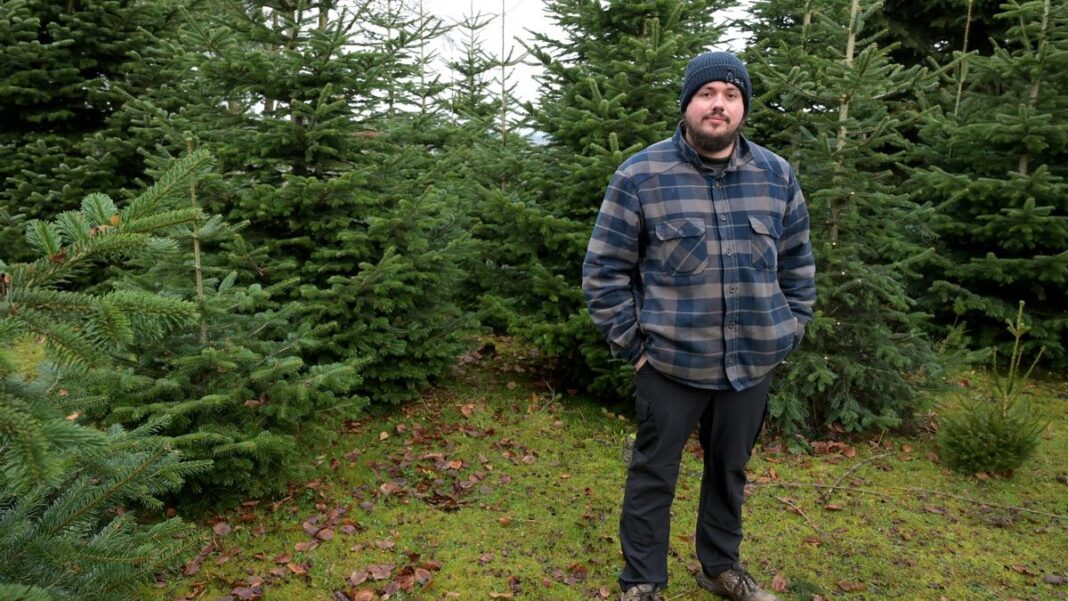Title: Uncover the Heartwarming Story Behind Luxembourg’s Christmas Tree Tradition
In the frosty winter air of Troisvierges, nestled in the far north of Luxembourg, Jimmy Schmitz stands amidst rows of Nordmann fir trees. A family tradition rooted deeply next to his home, tracing back to his grandfather Victor, a locomotive driver at CFL who ventured into the unconventional business of Christmas tree trading. "Back in the day, we even loaded spruces onto freight wagons to deliver them to Switzerland," reminisces Jimmy. Today, he continues the family legacy, still shipping Christmas trees to Switzerland. His father, Erny Schmitz, also took over the nursery, transitioning from a CFL employee to a self-employed horticulturist. In 2021, he passed on the business to his son Jimmy, who grew up surrounded by Christmas trees, recalling how he helped transport them even as a child.
For Jimmy, it was evident early on that he would follow in his family’s footsteps. After attending agricultural school, he dabbled in horticulture and landscape architecture studies but eventually returned to his roots, quite literally, by taking over the Schmitz nursery.
With the Help of Two English Sheep
Jimmy manages five hectares of land with two permanent employees and an unusual support system: two Shropshire English sheep. These domesticated sheep graze around the trees diligently, avoiding Nordmann firs. "They graze conscientiously around the trees," Jimmy explains. However, not all plots undergo intensive cultivation. Some areas are left to nature, preserving habitats for wildlife and insects.
Maintaining the trees is a science in itself. A healthy tree boasts a full crown without gaps, with magnesium playing a crucial role in retaining a saturated green color. "If the needles turn light green, it indicates a magnesium deficiency," shares Jimmy. However, they refrain from spraying chemicals, aiming for trees as natural as possible, without any chemical interventions.
The Journey from Seed to Living Room
Nordmann fir seeds often originate from the Caucasus, the trees’ place of origin, before arriving in Luxembourg to flourish in the Schmitz family fields. This process spans several years, covering an area equivalent to seven football fields. However, not all trees end up adorned with baubles and garlands in living rooms. Those unable to meet the standards, with missing branches or sparse crowns, find new life in Advent wreaths, for instance.
Demand has evolved over the years. While spruces, known for their resinous scent and prickly needles, were once popular, Nordmann firs now dominate the market. They are non-prickly and retain their needles longer. As temperatures hover around freezing, transitioning the tree indoors can stress them. "Some people position the tree right next to the fireplace or, worse, in an area with underfloor heating," Jimmy notes. Thus, acclimatizing the tree becomes essential.
A Touch of Nature Amidst Mass Christmas Products
Christmas trees are not just a commodity but a cultural element. "It’s something beautiful and alive to have at home," reflects Jimmy. Even though trees end up at the landfill after a few weeks, Jimmy isn’t disheartened: "There’s a cycle. For every tree felled, a new one is planted."
Climate change spares no one, including Troisvierges. "Trees must delve deeper for water," Jimmy explains, emphasizing soil maintenance and occasional liming to counter acidity from fallen needles.
Critiquing foreign competition, especially from Denmark shipping mass-produced Christmas trees, Jimmy advocates for local production. He believes Luxembourg can grow beautiful Christmas trees naturally, with minimal pesticide use. Despite this, young cultivators carrying forward the tradition are scarce.
Conclusion
The heartwarming tale of the Schmitz family’s Christmas tree tradition in Luxembourg showcases a deep connection to nature, sustainable practices, and a commitment to preserving traditions in a changing world. Jimmy’s dedication to producing natural, chemical-free trees underscores the essence of Christmas spirit and environmental consciousness.
FAQ Section
- Where did the tradition of the Schmitz family’s Christmas tree business begin?
- The tradition started with Jimmy’s grandfather, Victor, who was a CFL locomotive driver.
- What sets Nordmann firs apart in today’s market for Christmas trees?
- Nordmann firs are favored for being non-prickly and retaining needles longer compared to spruces.
- How does Jimmy Schmitz ensure the health of his trees without using chemicals?
- Jimmy focuses on natural growth, avoiding chemical sprays, and allowing trees to develop organically.
- How does Jimmy adapt the trees for indoor placement during the holiday season?
- To prevent stress on the trees, Jimmy advises acclimatizing them in a cool environment before bringing them indoors.
- What environmental challenges does Jimmy face in tree cultivation due to climate change?
- Increasingly, trees need to deepen their roots for water access, prompting Jimmy to prioritize soil maintenance and acidity control.
- What is Jimmy’s view on international competition, particularly from Denmark in Christmas tree production?
- Jimmy highlights the importance of local, natural production over mass-produced trees from abroad, emphasizing the quality and sustainability of Luxembourg’s trees.
- How does Jimmy incorporate sustainability into his Christmas tree business practices?
- Jimmy ensures a sustainable cycle by planting a new tree for every one felled, maintaining a balance between production and environmental conservation.
- What unique aspect of the Schmitz family’s business contributes to the Christmas tree tradition in Luxembourg?
- The Schmitz family’s commitment to natural growth, chemical-free practices, and cultural significance of Christmas trees enriches the tradition in Luxembourg.
- How does Jimmy’s approach to Christmas tree cultivation differ from conventional methods in the industry?
- Jimmy’s emphasis on natural growth, minimal chemical intervention, and sustainable practices sets his approach apart from conventional, mass-produced methods.
- What message does Jimmy convey through his Christmas tree business regarding environmental stewardship and tradition preservation?
- Jimmy’s business embodies a harmonious blend of environmental stewardship, tradition preservation, and a heartfelt connection to nature, reflecting the true spirit of Christmas.
Tags: Luxembourg, Christmas Trees, Tradition, Sustainability, Family Business
- Jimmy’s business embodies a harmonious blend of environmental stewardship, tradition preservation, and a heartfelt connection to nature, reflecting the true spirit of Christmas.

